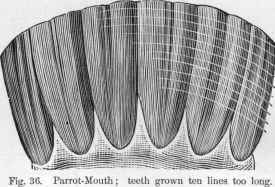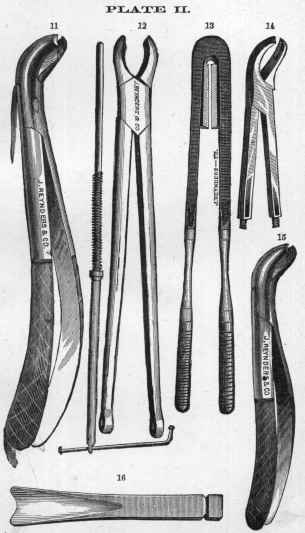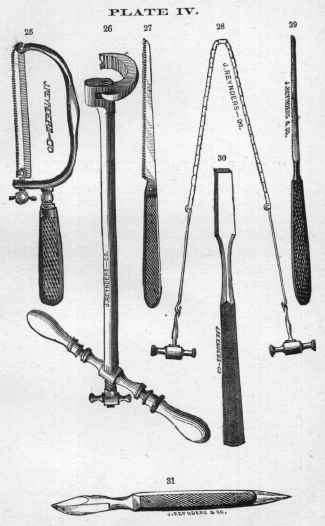DISEASES OF THE TEETH, MOUTH,
LIPS, ETC.
DECAY OR CARIES OF THE TEETH
Is rare, especially in young horses. The back teeth or
molars suffer more than the front teeth (incisors). They
are sometimes broken by stones or other hard substances
in the food. A severe blow over their roots sometimes
causes caries and the ultimate loss of the tooth. It is
possible to stop decay, especially of the front teeth, by
filling.
Care of the teeth is a matter of great importance. Mas
tication of the food is indispensable to digestion, and di
gestion to health. Owing to the fact that horses’ teeth
(except the tushes, which are practically useless), grow
throughout life—the growth counteracting the wear and
the wear the growth—sharp and dangerous projections
sometimes cause lacerations. When the teeth meet in
perfect apposition—grinding surface to grinding surface—
the wear is regular; when they do not, the unworn parts
will soon project. When they cause laceration of the cheek
or tongue, file them, but do not interfere with the natural
slant of the tables (crown or grinding surfaces). The
natural slant must be preserved, or mastication cannot be
properly performed. The molar teeth of the horse are in
this respect the reverse of human teeth.
Supernumerary teeth and dental cysts require surgical
skill. The so-called wolf teeth (really remnant teeth, for
they are the remains of what were once functionally de
veloped teeth), that appear in front of the first upper
DISORDERS OF THE TEETH. 143
molars, sometimes cause more or less trouble. It is bet
ter to extract them, which any one can do with ordinary
forceps.

Fig. 35. Abnormal growth begins at dotted line.
Figure 35 represents a back molar tooth which, on ac
count of the loss of the opposite tooth, grew till it killed
the horse.
PARROT-MOUTH
Consists in the upper front teeth—from irregularity and
overgrowth—projecting in front of the lower, like the
144 THE DISEASES OF THE HORSE.
upper bill of the parrot. The lower incisors are liable,
also from overgrowth, to injure the roof of the mouth.
Grazing is difficult and sometimes almost impracticable;
but the animal may be fed from the manger. The rem
edy is usually only palliative. Forceps, files, and surgical

skill are required, not only for parrot-mouth, but for many
other irregularities of the teeth, molars as well as incisors.
CRIB-BITING
Is doubly injurious to the horse. It wears and some
times breaks its teeth and gives it the colic—crib-biters’
colic—which is caused by the sucking in of air. Fur
ther, loss of saliva impairs digestion. The vice is a spe
cies of unsoundness. Breaking the front teeth interferes
with grazing.
Remedy.—Iron stable fittings. Manger, when not in
use, turned into recess in wall. Use muzzle or spiked
neck-strap. Concentrated, digestible food. Chalk, ant
acids, and an occasional laxative relieve the indigestion
from which crib-biters usually suffer. Separate crib-biters
from other horses, as they imitate and acquire the habit.
For a list of antacids, see page 31.
DENTAL INSTRUMENTS.
145


DENTAL INSTRUMENTS. 147
DENTAL INSTRUMENTS. 149


DENTAL INSTRUMENTS. 151
NAMES OF THE INSTRUMENTS.
1, 2, Adjustable Tooth Files. 3, Going‘s Tooth Chisel. 4, French model
of same. 5, Tooth Mallet. 6, French model Tooth Saw. 7, Narrow Tooth
Chisel. 8, Narrow Tooth Gouge. 9, Tooth Rasp, guarded. 10, Extra
blade for Adjustable File. 11, Heavy Forceps. 12, Going’s Forceps.
13, House‘s Cutting Forceps. 14, House’s Pulling Forceps. 15, Wolf
Tooth Forceps. 16, Wide Chisel. 17, Cutting Forceps, French model. 18,
Moller‘s Cutting Forceps. 19, Cutting Forceps, French model. 20, 21, 22,
23, House’s Cutting Forceps. 24, Narrow Gouge. 25, Bow Tooth Saw.
26, Key. 27. Plain Tooth Saw. 28, Chain Tooth Saw. 20, Fine ferruled
Tooth Saw. 30, Narrow Tooth Chisel. 31, Hurlburt’s Gum Knife and
Tooth Pick.
DISEASES OF THE MOUTH, ETC. 153
LAMPAS
Is congestion, fever and swelling of the gums and bars
of the mouth. It is peculiar to the young, but occurs
sometimes in the aged also. The eruption of the teeth,
especially the tushes, is probably the chief cause in the
case of the young, and their continuous growth through
out life the chief cause in that of the old. Direct irri
tation, bits, the action of certain foods, and gastric dis
order are also causes.
The remedy is lancing the gums and bars. Let the
blood out. Burning is not only useless but barbarous.
Soft or green food and astringent wash if necessary.
INFLAMMATION OF THE MOUTH (STOMA
TITIS),
Is simple or catarrhal, vesicular, pustular, and ulcera-
tive. It is peculiar to the young, and is attributed to
defective sanitary conditions, improper diet, and the effect
of wasting diseases.
A contagious pustular form of the disease occurred in
Berlin, Prussia, in 1876.
Remedy.—Careful feeding, laxatives, salines for gastric
disorder. In sucking foals and calves, besides local treat
ment, see that the mother’s milk is healthy and that she
is properly fed. Potassium chlorate or borax and glycer
ine solution. Dress ulcers with glycerite of tannin, or
paint with silver nitrate, 10 grains to ounce of water.
For doses, see pages 13 to 29.
INFLAMMATION OF THE TONGUE (GLOS-
SITIS),
Is rare.
Remedy.—Irrigate with mild astringent solutions. Ap
ply bismuth,
molasses, or vinegar. Soft, nutritive
food. Scarify if the swelling is extensive. If laxatives
154 THE DISEASES OF THE HORSE.
cannot be given per mouth, inject. For doses, see pages
13 to 29.
Tumor of the Lip, usually the lower, causes more or
less swelling. It is about the size of a pigeon’s egg, has
a firm feel, is hot, and gives pain when pressed. Its or
igin may, as a rule, be spontaneous, but it has been
known to arise from a bite or a sting. It usually bursts
internally in two or three days, discharging pus. Cleanse
and inject with a solution of alum or borax daily.
Tumor of the Face is peculiar to young horses and
usually appears on the side, between the eye and the an
gle of the mouth. Like other exostoses, they grow from
the bone; are round, broad at their bases, with little heat
and very little tenderness. They may be caused by blows,
and perhaps also by caries (bone rot). They do no great
harm unless they become fistulous; but they greatly dis
figure the face.
Salivary Calculi (stone-like concretions), are sometimes
found in the salivary glands, usually within their canals,
the parotid duct (canal), &c. An oat or other substance
penetrates the canal, or possibly pierces the cheek. It is
the nucleus for a stone-like or tartar-like concretion. Its
growth is slow. Sometimes it is superficial in depth, when
it can be seen or felt; but sometimes it is deep. Some
times it lacerates the membrane of the mouth, grating
against the teeth. It will usually more or less obstruct
the flow of saliva. Sometimes it causes swelling.
Stricture of the Esophagus (Œsophagus) is rare and
usually fatal. The tube (throat) sometimes becomes so
contracted at the part affected that it will not admit the
little finger. As the horse cannot swallow solid food, death
results from starvation.
Dr. Cheetham treated a case successfully by opening
DISORDERS OF THE THROAT.
155
the tube and passing probangs. The first, an inch and a
half in diameter, was followed by larger ones, which were
passed two or three times a day for ten days. Afterward
the owner of the animal passed the probang occasionally
himself. The stricture was seated at the point where the
tube enters the chest. A sac or pouch three or four inches
in diameter had formed near the stricture, and had acted
as a receptacle for food.
Rupture of the Esophagus.—Dr. Cartwright reports
a case of rupture eight inches long that “ had evidently
been made with some sharp or rough instrument.” The
mare died in eight days. A sheep’s probang stopped at
one-third of the neck.
Opening the Esophagus.—The esophagus lies near
but is deeper than, and, toward its center, somewhat to
the left of the windpipe. The incision must be made
carefully on account of the proximity of the jugular veins,
carotid arteries, &c. If the nature of the case will per
mit, open the left side of the neck, three inches longi
tudinally below its upper third, or near or at its center.
An assistant should press on the jugular. Near the wind
pipe will be found " a firm, cordiform, shining, red sub
stance.” This is the esophagus. Draw it outward with
a blunt hook, and make a longitudinal incision. Use a
tube if the case requires it. When through, stitch the
esophagus with silk and close the external wound with
pins. Apply a compress. Give liquid or soft food till
the wound heals.
Choking is usually the result of improper mastication
and greediness. Whole grains of corn, a small potato,
large pieces of turnip, egg shells, a hard ball of food—
even of grass—will sometimes lodge in the throat. Some
times a draft of water or the hand will clear the passage,
156 THE DISEASES OF THE HORSE.
but a probang is usually necessary. A cane, flexible if
to be had, a whalebone, the butt end of a whip, or any
similar instrument will answer the purpose.

Fig. 37. The Probang.
Dr. Holmes saved a horse from choking by opening the
esophagus and removing the obstruction. Dr. King saved
another by cutting down to the esophagus only. Finding
the obstruction, a ball of medicine, pliable, he manipulated
it. It was then washed down with water.
But first, if you want to come back to this web site again, just add it to your bookmarks or favorites now! Then you'll find it easy!
Also, please consider sharing our helpful website with your online friends.
BELOW ARE OUR OTHER HEALTH WEB SITES: |
Copyright © 2000-present Donald Urquhart. All Rights Reserved. All universal rights reserved. Designated trademarks and brands are the property of their respective owners. Use of this Web site constitutes acceptance of our legal disclaimer. | Contact Us | Privacy Policy | About Us |